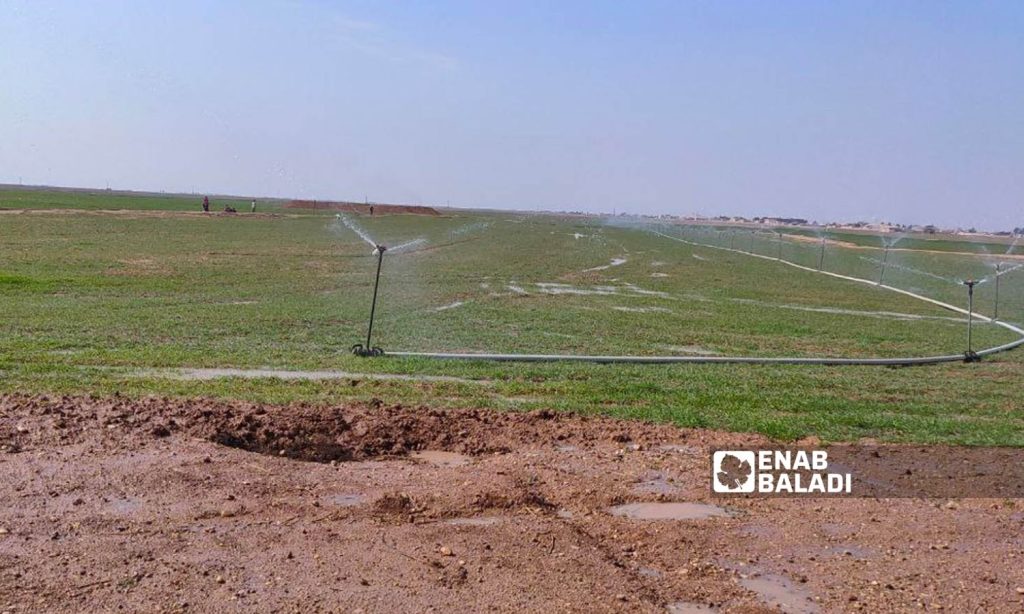Al-Hasakah – Majd al-Salem
Al-Hasakah farmers were optimistic in early February after the rains resumed after months of drought in the region, but the state of optimism did not last for long, as the rains stopped later.
The drought that hit the region this winter caused many lands planted with rainfed crops to be out of production due to the failure of the grains to germinate, according to what local farmers told Enab Baladi.
Meanwhile, other cultivated areas are about to fall short of production expectations, according to what agricultural engineer Tariq al-Ayed told Enab Baladi.
Some crops saved
The agricultural engineer considered that the previous rains came at a “critical moment,” and if they had continued for a few more days, they would have positively affected the thirsty rainfed crops.
Also, farmers of irrigated crops would have significantly benefited from these rainfalls because the rains meant they would stop irrigating their crops through wells, whose operation costs hundreds of thousands of pounds per day for fuel and other things.
The assistant director of the regime’s al-Hasakah Agriculture Directorate, Eng. Ezzeddin al-Hasso said in a previous interview with the official Syrian News Agency (SANA) that the rains that fell in early February “saved rainfed crops, especially wheat, and barley.”
He added that “the depression (low-pressure weather) will raise the germination rate of the two crops from 35% to double,” and it has “a major role in helping legume crops to germinate.”
Al-Hasso’s expectations did not reflect reality for the governorate’s farmers, as the rains stopped since February 10, which brought the rainfed crops back to the “dangerous stage” once again.
For his part, Engineer Tariq al-Ayed said that the coming days are “very critical” for rainfed crops, which are considered at the beginning of the production stage and are in great need of water.
Al-Ayed added that the return of the rains and the relative rise in temperature led to the evaporation of water from the soil surface and its drying, while the condition of the irrigated crops is good despite the difficulties farmers face in securing sufficient fuel to operate the watering wells.
He considered that the high prices of fertilizers, and linking them exclusively to the dollar exchange rate, also made it difficult for farmers of irrigated crops throughout the stages of the production cycle, as the price of one ton of “urea” fertilizer is about $750 on the black market.
For its part, the Autonomous Administration of North and East Syria (AANES) announced on March 5 that it had set the price of a ton of urea fertilizer at $630.
Whereas the problem with the fertilizer provided by the region’s authorities, according to what Enab Baladi monitored from several farmers, lies in the delay in the distribution and provision of the material by the AANES and its insufficiency for everyone.
The total area cultivated with rainfed and irrigated barley and wheat crops in al-Hasakah is about 707,000 hectares, according to SANA.
Breeders suffer, too
Livestock breeders, in turn, talked about the difficulties they face in raising and trading livestock.
Hayel Mohammad Rashid, 30, a sheep breeder from the southern countryside of Qamishli, told Enab Baladi that the rains improve the natural pastures, as it is followed by the growth of grass and weeds, which provide free food for livestock after the “high” price of fodder.
The rise in fodder prices, as a result of this year’s poor harvests, has led to losses for livestock breeders.
Rashid also said the rains encourage the population to raise and buy livestock. In early February, the livestock markets witnessed an improvement in the buying and selling movement and prices.
The price of a single sheep with its young lamb was about 1,500,000 SYP, and without its young, about 800,000 SYP, while the price of a “ram” was two million Syrian pounds, and a goat was about 500,000 SYP.
The abundance of fodder, the extent of its low prices, and the abundance of free pastures control the prices of livestock in al-Hasakah.
Green lands are considered free pastures for livestock breeders, and they are affected by the availability of rain or drought.
Hassan al-Sayyed, 52, a livestock breeder from the southern countryside of the town of al-Jawadiya, told Enab Baladi that the pasture situation has improved recently, and the burden of providing fodder on farmers has been reduced.
Al-Sayyed also expressed his fear that the rains will continue to decline after the rainfall was good in early February, given that the drought will lead to a decline in livestock prices once again.
He added that the fodder provided by the AANES is not enough for the livestock he owns, which is 35 heads of sheep, since AANES relies on old statistics to provide the allocations, noting that the number of livestock changes from day to day.
The Livestock Office of the Agriculture and Irrigation Committee announced on the official AANES website that it had started “delivering the third batch of bran to livestock breeders in Raqqa governorate.”
According to the announcement, “The allocation for one sheep amounted to two kilograms of bran, while the allocation for cows and camels amounted to ten kilograms per one, and the allocation for horses amounted to 35 kilograms per one.”
Meanwhile, the distribution process has not started until the moment this report was published, according to what Enab Baladi monitored during its interviews with livestock breeders in al-Hasakah.











